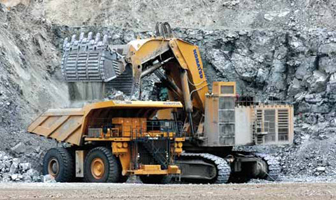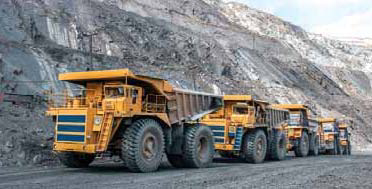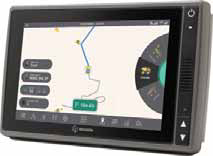
Truck-shovel haulage forms the backbone of many open-pit mining operations.
Fleet Management for Today and Tomorrow
We explore the integration of fleet management, health and safety systems and
how new technologies are paving the way for smarter, more efficient practices
By Carly Leonida, European editor

While haul cycle automation remains a mainstay for any fleet management system (FMS), mine operators’ expectations have grown infinitely. Today’s miners expect their FMS providers to not only leverage the advancements taking place within the mining sector, but to also take advantage of the innovations in automotive design, robotics, artificial intelligence, and many other non-mining-related industries.
To better understand how FMSs and mine networks have progressed, E&MJ spoke to Neil Ferreira, Associate Director Product Strategy at Modular Mining about the company’s DISPATCH FMS. “DISPATCH was built on the visionary concept that the backbone of every open-pit mine — the haulage cycle — could be made more accurate, efficient, and reliable, through computerized, automated dispatching,” he explained. “The DISPATCH system changed the game in 1979 when it was brought to market and introduced the concept of optimization to the mining industry.
“More than four decades later, optimization is still the cornerstone of the DISPATCH FMS and the Modular Mining brand. Our proprietary optimization algorithm continues to drive the real- time truck assignments that enable haulage cycle efficiency and increased productivity at open-pit mines around the world.” Advancements in wireless communications, multi-constellation Global Navigation Satellite System (GNSS) positioning, and onboard computer processing power, have contributed to the ongoing evolution of DISPATCH. And, on a broader scope, Modular Mining is working on new ways to harness the powers of data analytics, the IoT, and process digitization.
“By integrating these and other aspects of mainstream technology into our development processes, the DISPATCH system has the ability to help mines mitigate oft-seen challenges, such as wasted time during shift change, unreliable payload metrics, inaccurate material blending, and more,” said Ferreira. “By expanding our perspective, we can help our customers achieve maximum productivity, efficiency, and safety, across the entire mining value chain.”
An Integrated Approach to Fleet Management
Modular Mining, like many other FMS providers, has been working
hard to bring greater interoperability into its product suite
over the past 24 months. While this capability brings numerous
benefits in fleet automation, it’s also key to the integration of
different asset health monitoring and safety technologies.
“There is no shortage of offerings designed to address individual
segments of the operational big-picture,” Ferreira
said. “Often, these third-party systems generate vast amounts
of valuable data. Unfortunately, the external applications
rarely have native compatibility with other systems, which
leads to redundant hardware, additional infrastructure and
siloed functionality.
“For mines to experience seamless operation, the discrete technologies must communicate, exchange data and work together in a unified manner. Integration is the key component that will enable third-party systems, aftermarket OEM sensors, and FMSs to work synergistically and help mines achieve their goals of increased safety, efficiency and productivity. “In keeping with our corporate vision — sustainable mining powered by open technology solutions — we embarked upon a mission to increase our integration, interoperability and communication with relevant third-party systems. One outcome of this effort is the Modular Mining API (application programming interface) program.”
In accordance with its goals of increased openness and mine-wide optimization, and to satisfy customers’ need for connectivity between third-party applications, and the DISPATCH FMS and ProVision Machine Guidance Systems, Modular Mining released a series of APIs in May 2020. Based on internet-standard communications protocols, such as WebSockets and REST, the APIs facilitate bidirectional data exchange with the third-party applications, thus enhancing functionality at both ends.
The APIs target the key areas of supervisory control, payload management, crusher management, mine planning and aftermarket systems integration. Through them, the Modular Mining ecosystem gains access to previously unavailable information, to supplement real-time decision-making algorithms, automate tasks, and avoid duplication among systems. The APIs enhance third-party systems by providing real-time, read-only access to various endpoints including equipment positioning data, equipment status changes, and equipment cycle state changes. They also provide write-access to various entry points, including location status, equipment status, road state and material management.

“Going forward, we will closely monitor and evaluate the needs of our customers and the demands of the industry, and take a strategic, value-centric approach to augment the API program, accordingly.”
Ecosystems Create New Possibilities
While the mining industry is moving toward greater connectivity
and interoperability, and more comprehensive mine management
systems, this doesn’t mean that FMSs will be tasked with
running the gamut of functionality needed throughout the mine.
According to Modular Mining, FMS providers will instead
need to step up their efforts to facilitate real-time interoperability
with an ever-expanding range of third-party applications,
systems and aftermarket sensors. In the connected mine, each
component will do what it was designed to do — be it 3D visualization,
fragmentation analysis or weather tracking. And
then, through integration, interoperability and bidirectional data
exchange, the mining technology ecosystem will become more
robust, as a whole.
Another FMS provider looking to leverage technology ecosystems is Hexagon’s Mining division. The company’s MineOperate suite includes FMSs for both open-pit and underground operations, which integrate seamlessly with its safety, assistance and slope monitoring systems to provide autonomous capabilities. Hexagon refers to these as “Autonomous Connected Ecosystems” (ACEs). MineProtect portfolio manager, Marcos Bayuelo, and Mine- Operate portfolio manager, Larry Estep, shared their thoughts on future fleet management systems with E&MJ. “Over the past decade, we’ve seen a shift from data collection tools that provide information for mine operators’ decision-making, to tools that automate the decision-making process within fleet management and safety solutions,” Estep said. “This has helped to optimize productive material movement in real time without human intervention.
“Today, the interoperability trend in solutions for safety, mine design and automation across multiple technology providers makes it possible to automate machines and processes based on real-time decisions. This allows users to take the right action to optimize productivity and improve safety.” The evolution of technologies used to develop FMS solutions, the administration behind decision-making processes plus the quantity of data these systems generate have made it more challenging for mine operators to distill the necessary information. This has led to the development of data visualization and analysis tools that, from a single source of truth, provide the right information, in the right format over the life-of-mine.

Bayuelo added: “Increased computing power, wireless data transmission, onboard data volume transfer, peer-to-peer and other IoT technologies have also enabled fewer hardware components to be used for deploying most production and safety solutions. Solving productivity and safety challenges now requires fewer costs, and less maintenance, training and adoption time.”
More connected devices and solutions with reliable data mean better decision-making inputs, and new ways to solve challenges, such as a single way to provide positioning for all onboard solutions making data more reliable. A single user interface for vehicle drivers improves adoption and declutters the cabin and vehicle handrail (no more multiple GPS antennas or screens in the cab). Increased computing power also enables powerful computer vision and video processing solutions to run hand-in-hand with other safety and productivity solutions, like fatigue management systems, displaying an external awareness video feed with the FMS on a single interface.
The advent of faster, more widespread network infrastructure has also allowed the connection of back-end data with onboard devices for real-time, on-the-edge decisions and notifications, such as the connection of drill and blast and slope-monitoring solutions with fleet management and safety devices. This provides direct feedback to vehicle drivers on zones that are forbidden due to blasting, or a redirection to a new shovel to improve the cycle time.
Harnessing Smart Devices
The HxGN MineOperate OP Pro LP system, which will soon see
the release of version 3.0, gives mines greater visibility by combining
hardware and software to automate workflows, optimize
haulage and blending, and deliver situational awareness. By integrating
data, and automating production cycles and operations
workflows, OP Pro LP helps mines to better use their equipment,
improve their workflows, reduce costs and improve productivity.
MineOperate OP Pro provides real-time decision actions to
autonomous solutions using standardized onboard data sharing
APIs or software development kits (SDKs), such as Mission Manager.
It has improved and unified UI/UX interoperability, which
Estep said has added significant value for end-users, as it dramatically
improves usability and adoption.
Using these features and capabilities, Hexagon is now working toward creating integrated “smart device ecosystems” or SDEs for short, for fleet optimization. Estep explained in more detail: “Hexagon is driving its technology toward ACEs utilizing the data from multiple sensors and modularizing the solutions we provide in a simple hardware architecture that we call the Smart Device Ecosystem (SDE). It contains the same components to deliver the solutions to the specific challenges mines face. Mines can scale these solutions as needed via the same SDE already installed on vehicles and other infrastructure. “For example, in the same antenna, computing box and display, you could deploy: MineOperate OP Pro along with Reverse Assist; or OP Pro and our Asset Health module; or OP Pro with the HxGN MineProtect Collision Avoidance System (CAS) and Operator Alertness System (OAS).”
The idea is to allow mines not only to scale up solutions across their mobile fleets but to scaleup around their overall life of mine. For example, the creation of an ecosystem allows Hexagon’s IDS GeoRadar slope deformation system to send alerts in real time to all CAS-equipped vehicles. The MinePlan engineering suite will automatically synchronize the time and date of blast patterns with OP Pro to prevent vehicles from entering the vicinity, and to provide information in real time on whether vehicles are occupied or not. “Seeing connected devices from the same hardware creates great opportunities for efficiencies and cost-savings,” Bayuelo said. “The SDE will be made available in stages, so customers can adopt solutions as needed, and build incrementally according to their requirements.”

A Healthy Fleet is a Productive Fleet
Predictive analytics have also brought a new level of capability
and insight into the fleet management space over the past decade.
From helping determine how many trucks will be needed
at each location and when, to deciding the most efficient haul
routes and predicting machine failures… providing the data
quality and quantity are sufficient to train the models, the possibilities
in fleet optimization are almost endless.
Colin Donnelly, vice president of product engineering at predictive maintenance specialist Dingo, said, “Predictive analytics in any space can help you make better educated, smarter decisions over time. From our angle, we see predictive analytics as key to asset availability and uptime. The output from our system feeds into the mine FMS, which routes the machines to where they need be, so our system is complimentary to optimization. It’s up to the mine to determine how they use the equipment, and their FMS may have analytics behind the scenes to help do some of that too.”

“With predictive analytics, you’re actually collecting data and using it to determine when you next do maintenance, rather than working entirely to scheduled intervals.” Some tasks have to be done on a set schedule, for example, oil and filter changes, but there are also plenty of activities that can be performed based on machine or component condition. Donnelly said that many mines tend to over maintain their equipment. “We try and push them to let the data determine when to do certain tasks,” he said. “If you don’t have to do maintenance, don’t do it.”
With preventative maintenance, if a problem comes up after the machine has been serviced, then it will likely be another 250 or 500 hours before technicians get a chance to see it, and there’s a good chance a failure would occur beforehand. But, if that mine is collecting information through sensors, regular oil samples and other condition monitoring data, then there is an opportunity to be more proactive in the maintenance of that vehicle. Donnelly described the use of analytics in mine fleet health as “emerging.”
“There’s a wide spectrum,” he said. “We have some customers who had never looked at predictive maintenance before but had heard about the benefits. Then we have others who are really trying to push the limits and are using it to predict component failures. “For those customers, we’ve built some remaining useful life models that use anonymized data to identify that we’ve had a specific engine model fail with a particular failure type 10 times in the past. Can we use that information to predict when it’s going to happen? We’re working with approximately half a dozen customers on that type of approach to help them with logistics and planning.
“We can also provide, what I would consider to be a virtual assistant, where we use data feeds to make recommendations using machine learning and statistics on when to do corrective maintenance — change the oil, filters, or do a borescope inspection — those types of things.” Dingo has a data science team based in Brisbane that works closely with Queensland University of Technology and various subject matter experts to develop and train its models and algorithms.
“I think all mines would take advantage of predictive analytics if they were readily available to them,” said Donnelly, honestly. “But it’s not a plug-and-play technology. People often sell it that way, but when it comes to implementation, it’s not quite that simple. “If you want to predict a certain type of issue, then you have to collect the right data. It needs to be high-quality data with the accompanying history. A lot of mines are starting to realize that now. I’d say over the next two or three years, data collection and quality will improve, and we’ll really see a big uptake of this technology.”
Getting the Most From Analytics
So, where should mines start when looking to implement predictive
analytics?
“Don’t try to build the ocean up front,” Donnelly said. “Focus
on what your problems are whether that’s equipment health or
haulage optimization. Figure out what data you need to capture
if you’re not already capturing it, so that you have the right information
to help predict the problem before it happens.
“Some mines have machines that are really sensitive, but
they don’t have the infrastructure to get the data off the machine
quickly and back into a centralized office to make decisions
based on it, so check your communications and data
transfer systems too. That might be what’s holding you back.
“Look at how you could digitize your inspections. A lot of mines are still doing inspections on paper or using excel spreadsheets. We’ve had a lot of success with moving customers on to a mobile inspection app, which syncs customer’s inspection data into our system. Within five minutes of logging the data, a subject-matter expert, who could be on the other side of the world, can see that information with photos and provide support. “Also, make sure you have a solid maintenance strategy in place; you need to know what to do when you run into abnormal conditions. If you’re struggling with the basics, and you throw more data at it, you’re just going to have a bigger problem. Get the fundamentals right first.”
For mines that are already using predictive analytics and want to take their applications to the next level, Donnelly recommended looking outside of the operation, even outside of mining, to see what other industries are doing. There might be opportunities for improvement. And again, make sure historical data is well classified, because models that run on badly classified, incorrect data, can only provide poor outputs. “You could have the best models in the world, but if they’re running on bad data, they’re not going to give you the outputs you’re looking for,” he added.
Dingo’s Trakka cloud-based predictive maintenance software system provides mines with tools, insights and decision-support to run a best-in-class asset health program. Trakka can be integrated with existing asset health systems at an operation or run in parallel. “We’ve recently added the Inspect inspection app (mentioned earlier), which allows customers to collect data on equipment structural integrity,” Donnelly said. “Things like temperature and vibration measurements can be logged, and customers can collect digital images of frame cracks, etc. It’s designed to help mines digitize their inspections so previously static information can now be ingested and analyzed with other condition data to get the complete picture.
“We’re also working on a business intelligence reporting tool that will be released in Q2. This new capability empowers customers to connect directly to our database to do their own custom analytics and reporting. “We’ll also be giving customers direct access to our Power BI client, so that they can consume and share information in ways that they haven’t been able to in the past. We want to ensure that the insights and intelligence from Trakka is accessible and relevant whether you’re in the C-suite or on the shop floor.”